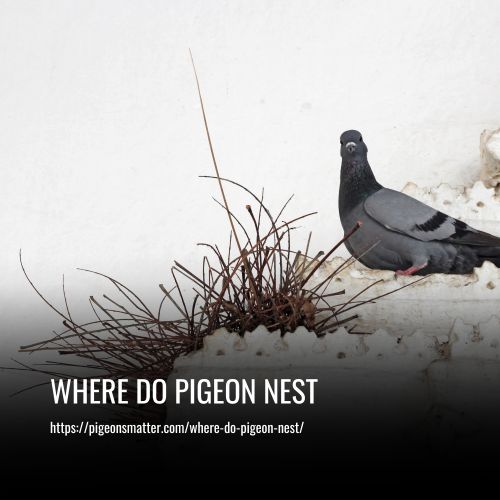Rock pigeons are a domesticated species that can be found all over the world, especially in urban areas where there are plenty of spaces for nesting. They typically nest on window ledges, under eaves, and inside abandoned buildings. Once a pair is ready to nest, the male brings small sticks and similar materials to the female, who weaves them into a nest that can become encrusted with old feces over time.
Wood pigeons, on the other hand, prefer to nest in woodland trees and hedges. They are commonly found in the UK and Europe and are becoming more frequently spotted in urban environments like gardens. While they are flexible with their choice of nesting sites, they typically prefer to build their nests in large deciduous trees at a height of around 5m, close to the trunk and major branches.

What do Wood pigeon nests look like?
Wood pigeon nests are simple and uncomplicated, consisting of circular platforms made of similarly-sized twigs. These nests typically measure between 20 and 30cm in width, which is just the right size for the birds. In urban areas, Wood pigeon nests may appear haphazard and hastily constructed, resembling the nests of feral pigeons.
Wood pigeons have been observed to select abandoned or unused nests of other birds as their nesting site. Although these nests may look fragile, many of them survive throughout the year and are even reused or improved upon in the following year. This is especially true if the pair of birds successfully raise a brood in that particular nest or nest site.
When do baby Wood pigeons leave the nest?
Baby Wood pigeons, also known as squabs, leave the nest after 30 to 36 days. This may occur earlier during the summer months. They may even leave the nest before they are fully fledged and migrate to a nearby tree.
Wood pigeons typically make their first flight after approximately 30 days, and tend to stay close to their parents during the following weeks. Their growth rate is fast after fledging, and they reach sexual maturity within 7 to 12 months.
Where Do Pigeons Nest in the Wild?
Pigeons are a common pest found throughout the United States, thriving in both rural and urban environments.
In their natural habitat, pigeons prefer to construct their nests in protected areas such as cliffsides and cave mouths. These areas provide shelter and safety for their young.
However, in urban environments, pigeons often roost on buildings and other man-made structures, causing damage and health hazards. It’s important to take measures to control their population and prevent them from nesting in unwanted areas.
Where Do Pigeons Nest Around the House?
Pigeons tend to select nesting spots near homes that resemble cliffs or caves in their natural habitat. They can be found nesting under roof eaves, attics, gutters, stairwells, and outbuildings.
1. Reusing Roosts:
Pigeons reuse their roosts for several generations of young, resulting in solid mounds of feces, broken eggs, and dead hatchlings. This can lead to foul odors, insect pests, and disease risks, posing significant health hazards for residents.
2. Homing Instinct:
The homing instinct of pigeons leads to repeated issues for homeowners as they return to their nesting sites annually. It’s important to take action to deter pigeons from nesting near your home to prevent these issues from arising.
Can’t I just move the Pigeon Nest?
It is not recommended to move a pigeon’s nest, even just a few feet away. Pigeons are very location-specific when it comes to their nest site, and moving the nest can cause the parents to abandon it.
Baby pigeons need their parents for survival, as they feed and care for them, and teach them important skills even after they leave the nest. If you move the babies to a different location, even a “nice” spot like a park, they will not survive.
It is best to let the parents raise their babies on your balcony, which will take less than a month. After the departure of the baby pigeons, measures can be implemented to deter future nesting on your balcony.
The Pigeon Nest: Pigeon Nesting Habits And Behaviors
Pigeons have a unique way of building their nests, which involves collecting sticks, twigs, and other materials to create a platform. They often build their nests on ledges, rooftops, or other high areas, and sometimes even reuse old nests.
Both male and female pigeons take turns sitting on the eggs, with the male typically taking the day shift and the female taking the night shift.
After the eggs hatch, both parents care for the young in the nest until they are ready to leave. Understanding pigeon nesting habits can help people appreciate and coexist with these birds in their environment.
1. Pigeon Nest Locations:
Pigeons have specific requirements for nesting sites, which include a dry and protected flat surface. They commonly nest in attics, on roofs, ledges, eaves, and under bridges.
In their natural habitat, they prefer to nest in rocky cliff crevices or caves, which is why they tend to nest on high, flat ledges. Providing a suitable nesting site for pigeons can help support their population and ensure their safety.
2. Courting And The Nest:
Male pigeons play an active role in building their nests and attracting a mate. They start by calling out for a mate and building the nest. If the female is interested, they will “kiss” by billing each other.
Once the female is interested, the male will start searching for nesting material and bring it to her one twig at a time. If the female can’t keep up, he may drive her into the nest and strike her with his wings.
Once the nest is built, the female will take over incubating the eggs overnight while the male sits during the day. Pigeons typically mate for life and will only mate with another bird if they are separated or one passes away. They can have up to 10 squabs per year and nest throughout the year.
3. The Look Of A Pigeon Nest:
Pigeon nests may not be the prettiest sight, but they serve an important purpose for these birds. They are made up of a messy pile of materials such as grass stems, pine needles, twigs, sticks, and other debris, with a small depression in the middle. Pigeons do not remove droppings from the nest, which can accumulate and essentially glue together all of the nesting materials over time.
After a brood leaves the nest, the pair may choose to reuse the same location for the next brood, adding new nesting material. These reused nests may contain remains from previous broods, such as pigeon mummies and unhatched eggs. With multiple years of use, a nest may grow up to eight inches tall and 20 inches wide, weighing close to five pounds.
4. Nest Eggs:
Pigeons have a unique nesting and breeding process. The female pigeon lays about two eggs within the first few days of nesting, and both the male and female take turns sitting on the eggs to insulate them. The female usually sits on the nest from the afternoon to the morning for about 18 days.
Once the eggs hatch, the young pigeons, called “squabs,” are born covered in yellow down and are fed crop milk, which is the thick regurgitated liquid from the parents’ mouths. After about ten days, they start eating what the adult pigeons eat and double in size in just two days, making them one of the fastest growing vertebrates.
In two weeks, they get their flight feathers, and by their third week of life, they are covered in feathers, with their tail fully feathered by their 28th day of life. At this point, it’s time for the squabs to leave the nest. They stay in the nest for about 15 days longer than most backyard birds. Following the departure of the squabs, the female pigeon will commence laying new eggs approximately once a month.
4. Getting A Glimpse Of Squabs:
Baby pigeons are rarely seen by humans because they love their nests and stay there until they are fully grown. These young birds remain in their nests as their feathers grow and develop.
This is because they are vulnerable to predators and are often eaten as a tasty meal. Once they are fully grown, they will finally leave their nest. It can be difficult to identify a young pigeon, but one way is to look for a lack of a white flash on its neck.
Woodpigeons, which are short and fat, are a common type of pigeon found on lawns. Despite their elusiveness, it’s important to ensure that baby pigeons are protected and their environment is safe so they can thrive.
5. Returning Home:
Pigeons are known for their loyalty to their nests, where they may have multiple broods. They have a remarkable ability to return to their home, which has been utilized for centuries. Pigeons were used as messengers as far back as 2500 BC, and ancient civilizations such as the Greeks, Romans, Persians, and Syrians all used them for this purpose.
In the 19th century, pigeons carried messages for news agencies and financial institutions in Europe and even provided an airmail service in New Zealand. Pigeons are adept at carrying messages and can gather food all day before returning to their nest without issue. Their homing instinct is truly remarkable and has been utilized by humans for various purposes throughout history.
Pigeon Nests And You
If you live in an area where pigeons are common, you may want to consider providing them with nesting options or deterring them from nesting in your area.
- Nesting Options: If you want to provide nesting options for pigeons, consider installing nesting boxes or platforms in high areas such as rooftops or balconies. These should be made of sturdy materials and have appropriate drainage to prevent water buildup. Pigeons prefer nesting in open, flat areas, so make sure the nesting area is clear of any obstructions.
- Deterrents: If you want to deter pigeons from nesting in your area, there are a few options. You can install bird spikes on ledges or other flat surfaces, or use bird netting to cover areas where pigeons may try to nest. Another option is to use visual deterrents such as reflective surfaces or fake predators like owls or snakes to scare the pigeons away.
- Moving A Nest: Moving a pigeon’s nest should only be done by licensed professionals as the nest location is crucial to their survival. Pigeons do not have a sense of smell to find their new nesting location, so if you move a nest, the parent may abandon their young. It is important to note that young pigeons require their parents’ guidance even after leaving the nest. Both the male and female will continue to teach their offspring survival skills, such as escaping from predators, flying, and socializing with other pigeons.
- Backyard Tips: If you spot a pigeon in your backyard, it’s important to be aware of their feeding habits. Pigeons are attracted to large, open areas where it is easy for them to find food on the ground. Feeding pigeons in your yard can attract rodents, therefore it is advisable to limit pigeon feeding. They enjoy peas, dried corn, or sorghum. By being mindful of their feeding habits, you can help keep your backyard clean and free of pests.
When Do Pigeons Nest?
Pigeons are known for their prolific breeding habits, with females laying eggs and raising young about every 30 days, provided the weather is favorable. This cycle can result in up to six batches of young per year, making them highly adaptable and successful in urban environments.
Do Wood pigeons nest in the same place every year?
Wood pigeons are non-migratory birds in the UK and Ireland, and they tend to either reuse their old nests or build new ones close by if their previous nest is still intact.
These birds tend to stay close to where they were born, and many juveniles will return to their natal habitat to breed. As a result, if you have Wood pigeons in your garden during the spring, you may notice that they come back every year.
Wood pigeons from various parts of Europe migrate and return to their breeding sites every year.
Do Pigeons Reuse the Same Nest
Pigeons often reuse the same nest site, building new nests on top of the previous ones. This results in older nests that can measure up to 7 inches in height and 19 inches in width.
It’s important to note that the same nest site is being used, rather than the same nest being used repeatedly. This behavior is common among pigeons and is a natural part of their nesting habits. By reusing the same site, pigeons are able to save time and energy when building their nests.
FAQs
The common pigeon, known as the feral pigeon, tends to nest in areas with access to food and water, such as parks, city buildings, farms, and feed mills.
Pigeons tend to cluster together in flocks and share a building. They prefer a variety of nesting places. Pigeons find it easy to nest in areas with many nooks and crannies and minimal disturbance.
Certain species of pigeons have been known to nest in trees close to human settlements. One such species in the UK is the wood pigeon, which is not considered a nuisance as it also nests in trees but is close to roads. Although their diet is similar to that of the feral pigeon, they are not associated with the negative connotations of the “flying rat” label due to their lack of impact on people’s homes.
Don’t worry about pigeons using your building as a nesting place. They gather materials from the environment to create saucer-like nests. Although the nests may appear flimsy at first, they become stronger over time due to pigeon droppings. Pigeons also have a habit of reusing and adding onto their previous nests, so keep that in mind if you find an abandoned one on your property.
To remove pigeons in the UK, you must follow certain laws. Killing them is illegal under the Wildlife and Countryside Act 1981. Instead, focus on deterring them and preventing nesting. There are various methods to accomplish this goal.
To deter birds from roosting, make their areas unappealing. Eliminate any food sources. Seal off entrances to the attic and chimneys. Place reflective objects and fake predators in the area.
Relocating a bird’s nest is prohibited under the Wildlife and Countryside Act of 1981, as the nest and its contents are protected. Only licensed individuals may move a wild bird’s nest, contingent on meeting specific conditions.
When faced with a pigeon infestation in your building, it is recommended to seek advice from a professional bird controller.
Conclusion:
Pigeons are resourceful creatures that can make a home almost anywhere. From balconies to trees to rooftops, they will find a spot that suits their needs. While they may seem like a nuisance to some, they play an important role in our ecosystem and should be appreciated for their adaptability and resilience.
So next time you spot a pigeon nest, take a moment to admire these feathered architects and the incredible homes they create.


